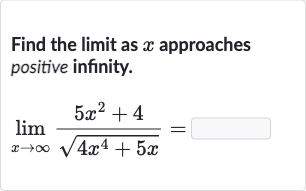AI tutor
Full solution
Q. Find the limit as approaches positive infinity.
- Simplifying the expression: To find the limit of the given function as approaches positive infinity, we need to analyze the behavior of the numerator and the denominator separately. We will start by simplifying the expression by dividing both the numerator and the denominator by the highest power of in the denominator, which is .
- Removing terms as x approaches infinity: Divide the numerator and the denominator by : Simplify the expression:
- Simplifying the square root: As approaches positive infinity, the terms and in the expression will approach zero. Therefore, we can simplify the expression further by removing these terms:This simplifies to:
- Final step: approaching zero: Now, we can simplify the square root in the denominator: (since is approaching positive infinity, we consider only the positive square root). So the expression becomes:
- Final step: approaching zero: Now, we can simplify the square root in the denominator: (since is approaching positive infinity, we consider only the positive square root). So the expression becomes: As approaches positive infinity, the term in the denominator will also approach infinity, making the whole fraction approach zero:

